Menus
- Today a king
- Big Bike Development Highlights
- Honda CB 1100 F: A royal fine spirit
- Kawasaki GPZ 1100: From the attack department
- In detail: Honda CB 1100 F
- In detail: Kawasaki GPZ 1100 B2
- Opinions
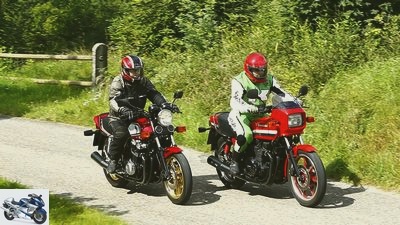
www.factstudio.de
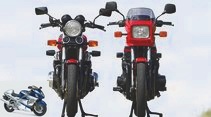
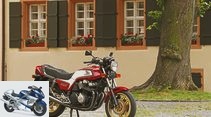
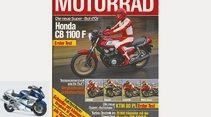
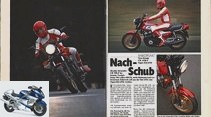
29 photos
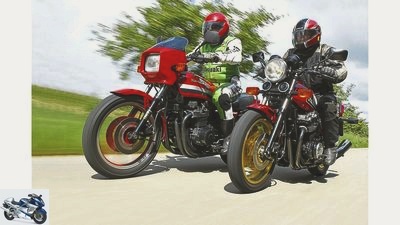
factstudio.de
1/29
Picture gallery: Honda CB 1100 F and Kawasaki GPZ 1100 B2 on the move.
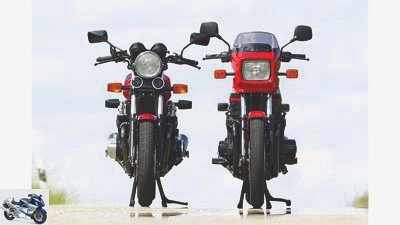
factstudio.de
2/29
Honda CB 1100 F and Kawasaki GPZ 1100 B2.
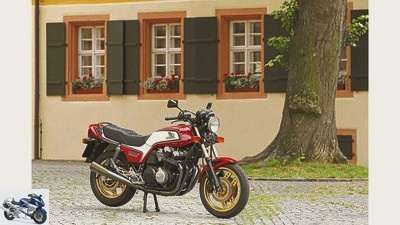
factstudio.de
3/29
The coronation of the series: Even after more than 30 years, Honda’s Super Bol d‘Or has lost none of its majestic charisma.
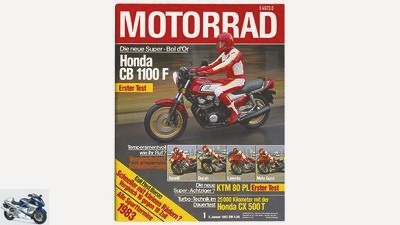
4/29
Top engine with unstable chassis at high speed …
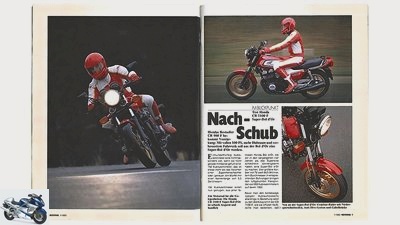
factstudio.de
5/29
… – so the conclusion of the test of the CB 1100 F in MOTORRAD 1/1983.
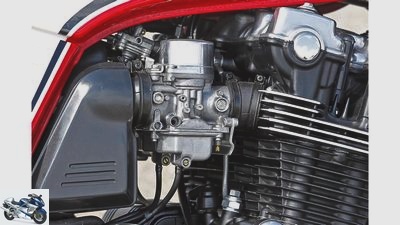
factstudio.de
6/29
Four 33 Keihin carburettors supply the combustion chambers with a mixture.
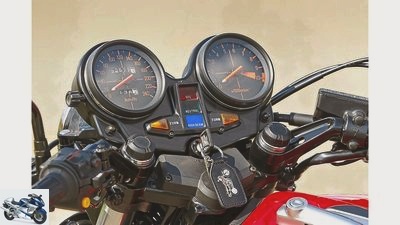
factstudio.de
7/29
Easy to read instruments, fork with adjustable damping.
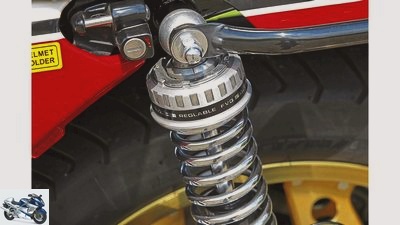
factstudio.de
8/29
Suspension struts with adjustable damping of rebound and compression.
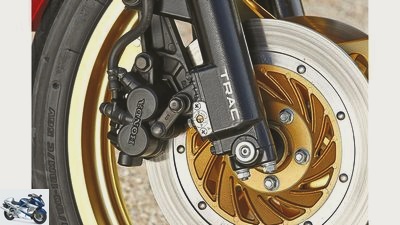
factstudio.de
9/29
Effective brakes, almost ineffective anti-dive system.
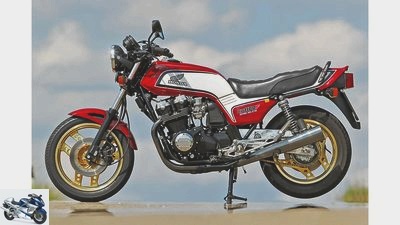
factstudio.de
10/29
Honda CB 1100 F (1983-1984); Price 1983: 11,178 marks.
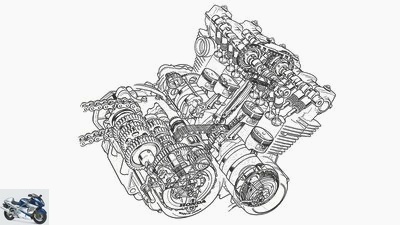
11/29
Chain reaction: three chains for primary and camshaft drive.
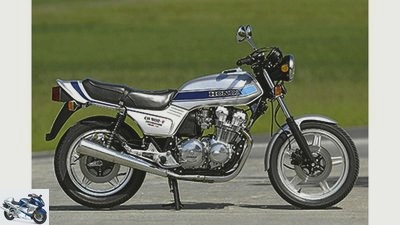
factstudio.de
12/29
History: 1978: Premiere for the CB 900 F in the flowing design known as “Euro-Style” (type SC 01). The dohc four-valve engine with 95 hp is a completely new design. Price: 10,422 marks.
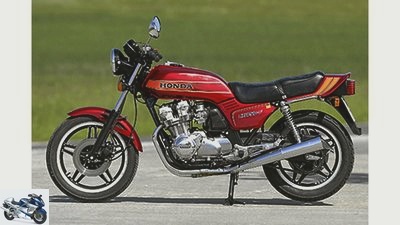
factstudio.de
13/29
1980: CB 750 F (RC 04) with 78 hp as an addition to the series. Adopts style and technology from the 900s, as well as the Comstar wheels with the now reversed spoke profile. Price: 8,772 marks.
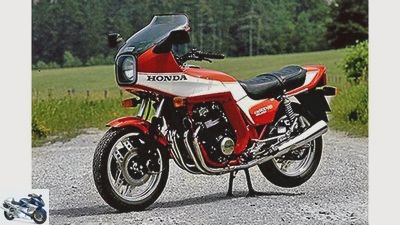
14/29
1981: Honda offers the CB 900 F2 with fairing for touring riders. New: double-piston floating caliper brakes and 37 fork, also for the standard model. Price: 11,044 marks.
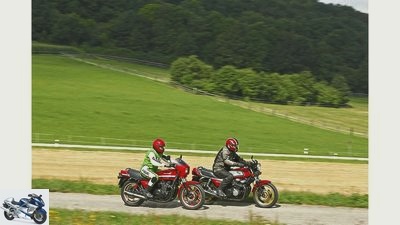
factstudio.de
15/29
Kawasaki emphasizes sporty, Honda rather elegant. In terms of performance, the two 1100s don’t give each other anything.
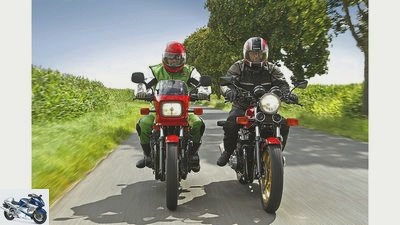
factstudio.de
16/29
Suitable for touring: Both 1100s have comfortable benches and allow a relaxed posture.
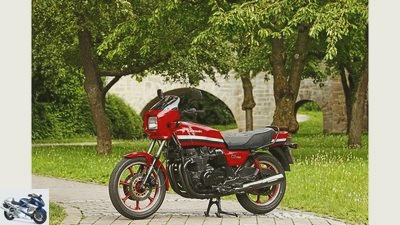
factstudio.de
17/29
For many the most beautiful GPZ 1100: the B2 model from 1982 with cockpit fairing and two struts at the rear.
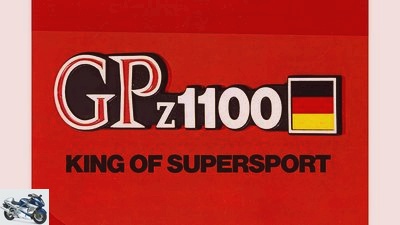
18/29
This is it, the original brochure of my childhood dream. …
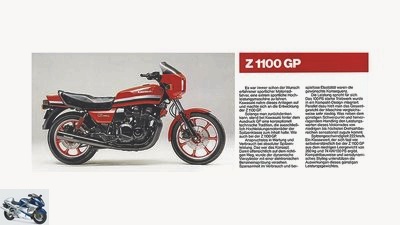
19/29
… Guarded like a treasure for over three decades. The series did not have the red oil cooler.
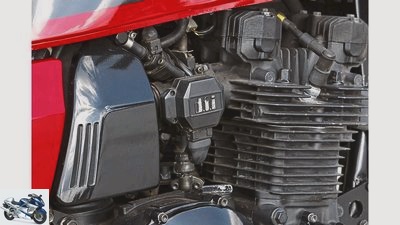
factstudio.de
20/29
Map-controlled injection system, cylinder head from the Z 1000 J.
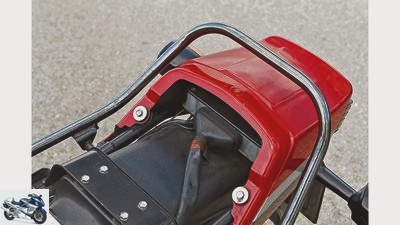
factstudio.de
21/29
Computer for the injection, housed in the rear apron.
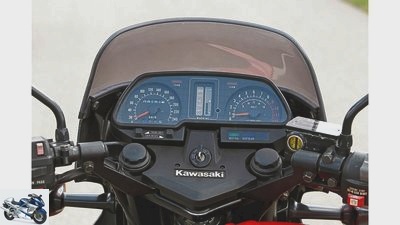
factstudio.de
22/29
Cockpit with small instruments and additional LCD displays.
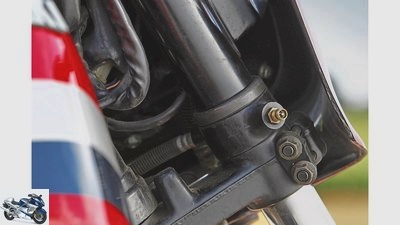
factstudio.de
23/29
Air-assisted fork, connection hose to the second spar.
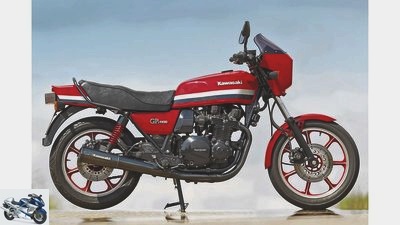
factstudio.de
24/29
Kawasaki GPZ 1100 B2 (1982); Price 1982: 10,730 marks.
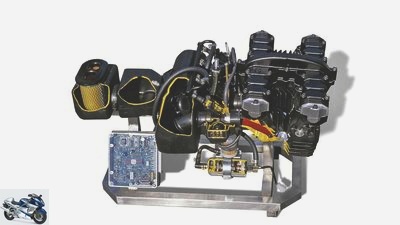
25/29
DFI with map control and injection nozzles in the throttle body.
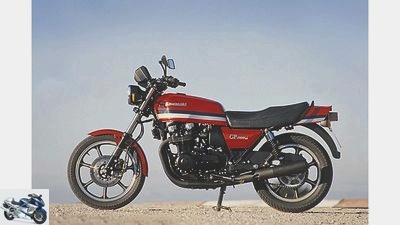
Frank Herzog
26/29
History: 1981: Debut of the first type B1 GPZ 1100, recognizable by the unclad “bread box” cockpit. With Bosch L-Jetronic injection built under a Japanese license. Price: 9790 marks.
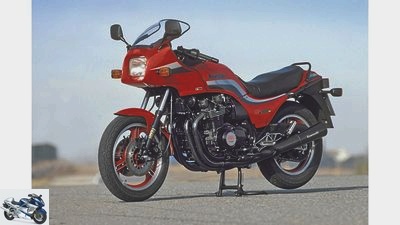
27/29
1983: New model GPZ 1100 UT, with 120 HP in the open version. Chassis now with a “Unitrak” rear suspension with central spring strut. Price: 11,190 marks.
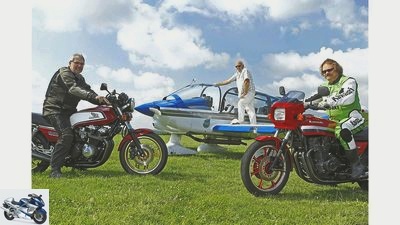
factstudio.de
28/29
One plane and two high-flyers – the Super Bol d‘Or and GPZ 1100 were once the ultimate in classic big bikes.
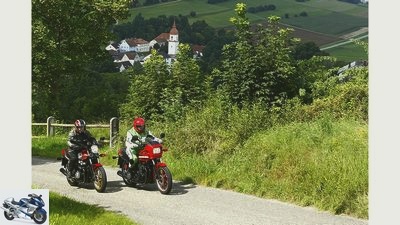
factstudio.de
29/29
Picture gallery: Honda CB 1100 F and Kawasaki GPZ 1100 B2 on the move.
On the move with Honda CB 1100 F and Kawasaki GPZ 1100 B2
Today a king
Content of
What a sublime feeling to be able to go on tour with the dream bikes of the youth in imperial weather – a Honda CB 1100 F Super Bol d’Or and the Kawasaki GPZ 1100, the “King of Supersport”!
F.For almost 35 years the six-page leaflet with the bright red title was in the brochure cover, neatly archived in the folder with many other motorcycle brochures. A folder like a little treasure chest, full of my motorcycle dreams that once seemed out of reach. A colorful hodgepodge spanning over three decades that now and then seems like an oversized “to-do list” because I naturally want to ride as many of my dream bikes as possible.
Buy complete article
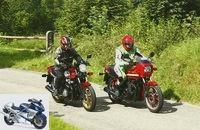
On the move with Honda CB 1100 F and Kawasaki GPZ 1100 B2
Today a king
Kawasaki GPZ 1100. To be more precise: the B2 model from 1982 with the small cockpit fairing, which the Kawa advertisers once made the “King of Supersport”. At least that’s what it says on the title page of the fold-out brochure. I stole it from the dealer when I could only afford half a Kawasaki portion with the Z 550. So the king still had to wait – for 34 years!
I have Ralf Gnatzy to thank for the fact that an audience still works after so many years. The Franconian, who has been a Kawasaki fan through and through since his youth, owns several other Kawasakis and all three GPZ 1100 models. Today he leaves me with the B2 one of my biggest youth swarms for a trip. Manfred Geiger accompanies us with his Honda CB 1100 F..
Big Bike Development Highlights
The Augsburg resident bought his Super Bol d’Or online in 2009, in what appeared to be a very good, untampered condition, with only 12,000 kilometers on the clock. But the supposed stroke of luck soon turned out to be a major construction site. The unmistakable traces of acid underneath the carburetor were so serious that the engine housing had to be replaced because the material was too weak. Since the right cylinder had hardly any compression either, the mechanical engineer decided to undertake an uncompromising, complete restoration, despite the overall very good condition. New engine housing, cylinders ground to a second oversize with matching pistons, overhauled valve guides, fresh paint on the frame and top of the tank – just the whole program that Manfred considered necessary for a perfect restoration down to the last detail. Thanks to the new black chrome coating, even the rear-view mirrors shine in the glaring sunlight to compete with that of the exhaust system.
As the crowning glory of the Bol d’Or series, Manfred’s new and absolutely original CB 1100 F is the ideal companion for me on the excursion with the “king of super athletes”, because the two displacement cars represent the preliminary high and low point of the classically drawn Big Bikes. Both at Honda and Kawasaki. The fact that the Super Bol d’Or only came onto the market in 1983, when the GPZ 1100 B2 had already abdicated in favor of the more modern Unitrak variant, is therefore irrelevant today.
Honda CB 1100 F: A royal fine spirit
For lovers of these displacement giants, a classic appearance is more decisive. And in this regard, both the Kawasaki and the Honda can score. The GPZ in contrasting red and black looks beefier and more aggressive, makes an attack even while standing. Looks like she doesn’t shy away from an argument. In direct comparison, the four kilogram heavier Honda comes across to me very differently, somehow slimmer and more elegant. A two-tone metallic paintwork, shiny, polished engine cover and gold anodized Comstar rims really give the CB 1100 something majestic. In contrast to the unmistakable presence of the Kawasaki, one could see something like a royal fine spirit in the Honda, which wants to impress less with its power and more with fine manners.
Is there anything to it? So let’s get into the saddle of the Honda and hit the button. The Super Bol d‘Or hums softly from the two silencers, in which reducing sleeves limit the open power of around 110 hp to the 100 hp limit that was then applicable in Germany. You don’t have to worry about it, the power of displacement can be felt anywhere and anytime, even with 100 hp. Likewise, the striking smoothness of the large four-cylinder, which, thanks to the engine mounting in rubber elements, is more reminiscent of an electric motor than an internal combustion engine. The tingling of the smaller 900 Bol d’Or, which was always criticized for it, is no longer noticeable in the 1100. The Honda also works softly with the clutch and transmission, everything works very precisely and smoothly. Also great are the clearly arranged instruments and the comfortable bench – on the first few kilometers out of the urban hustle and bustle, the Honda makes every effort to make my life as easy as possible.
That does not change on wide sweeping country roads. Only here the four-cylinder plays itself in the foreground. Still running steadfastly smoothly, the 1062 four-valve engine is already putting a lot of pressure on in the lower speed range. The tachometer needle quickly bridges the middle range, and the Four adds a few more briquettes towards the redline at 9500 rpm. So there is pressure in abundance in all situations, even if presented in a rather unspectacular manner. No roaring roaring from the intake, no roaring from the exhaust, no vibrations on the handlebars and footrests – perfect!
But maybe a little boring? If you ask yourself this question, you are definitely on the wrong motorcycle. There is no question that there are much more powerful motorcycles today, including those with more character. But not for discussion here. My impression of the Honda 911 is an extremely positive one, even when compared to more modern designs. Surfing across the country at around 4,000 tours in fifth gear at 100 km / h and enjoying a full thrust with a twist of the right wrist – that is not a question of age with big bikes.
More like the driving behavior. On this point, the Super Bol d‘Or does not enjoy the best reputation, despite measures to improve stability compared to the 900, such as a flatter steering head angle (62 degrees) and more caster (120 mm). Nevertheless, in old test reports there is talk of commuting in fast corners, also of swinging on transverse joints at high speed – free! Manfred also knows how to tell about wobbling beyond 150 km / h, but he knows a tried and tested antidote: no excessive speed! When wagging around bends in the usual highway speed window, I had no problems. You have to give the Honda the direction with a short pull on the handlebars, then it will reliably find its line, supported by the easy-to-grip Bridgestone BT 45.Suspension and damping also play a role in moderate gasping, even the brakes are at this speed with surprisingly good controllability at all times grown. When I hand the Honda back to Manfred after an extended test lap, I am a little irritated that I hardly find any points of criticism. Whether the Kawasaki, my secret favorite, will also succeed?
Kawasaki GPZ 1100: From the attack department
Ralf’s GPZ 1100 comes from Switzerland and has only run almost 9,000 kilometers. Despite small signs of use, it is in an excellent original condition. “I can always restore it later,” the 52-year-old comments on my reference to the blue plume of smoke when accelerating. He is right, especially since the 1100 is mechanically just as quiet as the Honda counterpart. And is known to burn loads of oil. “Don’t worry and just drive!” No sooner said than done.
As soon as I accelerated for the first time, my doubts that, due to the almost identical data, the differences between the Honda and the Kawasaki could be too small for me to drive them out on this one test lap. Because the B2 is also a real Kawasaki. Roar from the intake tract as I accelerate, so that the hairs on my neck stand up, with the typical Kawa hissing from the two silencers as accompanying music. It also tingles – depending on the speed – here and there, and not too scarcely. Yes, this Kawa is alive too, compared to the highly cultivated Honda, it is more of a riot, shows a completely different, wilder character. Emotionally, the roller-bearing two-valve valve does not shovel quite as much torque on the crankshaft at the bottom, but turns more greedily at the top. With the popometer as the only measuring instrument, however, I cannot say with the best of will which of the two works better. The Kawa two-valve engine does not seem to have any real disadvantages compared to the Honda, which has been blessed with twice the amount, at least subjectively. Especially not with the mixture preparation. The map-controlled injection of the GPZ 1100 B2, which is improved compared to the B1, simply works perfectly, accelerates wonderfully smoothly and delivers the perfect mixture in every load condition – without any hiccups.
In the upper room, I therefore long ago saved a tie in the drive when I headed for more curvy terrain with the Kawasaki. The GPZ feels a bit more light-footed here than the Honda, and it works more quickly in an inclined position if you suppress the slight wobbling due to the steering head bearing that is too tight. Ralf knows, of course, that there is a need for action here – as with the unusually blunt brake pads. But the appointment was set at short notice because of the freak weather – thanks again to the two Big Bike owners who made this comparison possible for us! That’s the only reason I can report that you sit more relaxed on the “King of Supersport” thanks to the lush, padded seat and the more open knee angle than on the Honda, which is already very pleasant in this respect.
In addition, I can now better classify the former criticism of the testers of the unstable high-speed behavior of the two displacement bolides. Because in normal everyday life on this side of the autobahn, both drive with confidence. In addition, owners of such high-performance classics today usually display a similar aplomb as their engines – and pull the cable with the necessary respect for the age of the material. Nevertheless, I really enjoyed myself with the 1100s, both of which have their own character.
However, the fact that I remember the Honda more strongly in the end gives me pause. I didn’t find the brochure of the CB 1100 F in the collection of my dreams…
In detail: Honda CB 1100 F
factstudio.de
Honda CB 1100 F..
(1983-1984)
Price 1983: 11,178 marks
Data (type SC 11)
- Engine: Air-cooled four-cylinder four-stroke in-line engine, two overhead camshafts, four valves per cylinder, actuated via bucket tappets, bore x stroke 70 x 69 mm, displacement 1062 cm³, output 74 kW (100 PS) at 8500 rpm
- Power transmission: Multi-disc oil bath clutch, five-speed gearbox, chain drive
- Landing gear: Double loop frame made of tubular steel, telescopic fork, Ø 39 mm, two-arm swing arm made of box sections with two spring struts, Comstar composite wheels, tires 100/90 V 18 at the front, 130/90 V 17 at the rear, double disc brake at the front, Ø 276 mm, double-piston floating caliper, disc brake at the rear Double piston, Ø 276 mm
- Mass and weight: Wheelbase 1520 mm, tank capacity 20 l, weight with a full tank 264 kg
- Top speed: 224 km / h
technology
Exactly 160 cubic centimeters more than the 900 and a thoroughly modified chassis characterize the undisguised top model of Honda’s Bol-d’Or series. Honda achieved the increase in displacement to 1062 cm³ with larger pistons, now 70 instead of 64.5 millimeters. The Super Bol d’Or practically took over the inner workings of the sporty flagship, the CB 1100 R. Instead of expensive magnesium and a finely balanced crankshaft, however, the normal parts of the 900 were used in the civilian 1100. German buyers also had to forego full power, which was around 110 hp abroad. Reducing sleeves in both silencers reduced the power to the 100 hp that were common in Germany at the time. The chassis was based on the model-upgraded CB 900 F of the SC 09 type for 1982, so it had the revised fork with 39 mm stanchions and anti-dive, low-profile tires and an engine mount in vibration-reducing silent blocks. To improve the driving stability at high speeds, Honda extended the caster on the 1100 by 10 to 120 millimeters, and the steering head angle was 0.5 degrees flatter, now measuring 62 degrees. In contrast to its 900 sister, which was equipped with 18-inch wheels at the front and rear, a 17-inch rear wheel rotated in the needle-bearing box swing arm of the Super Bol d’Or, although the tires had a higher 90 mm cross-section.
Purchase check
After more than 30 years, you shouldn’t be fooled by the basic robustness of the dohc four-valve engines of the Bol-d’Or series. Because time, many kilometers and previous owners leave their mark. A typical feature of the CB 1100 F today is high oil consumption, especially when it is brisk. Too bad that there are no longer any oversized pistons from Honda. The problem areas still include defective alternator rotors and crumbled timing chain slide rails. The latter require the engine to be removed for repairs. Problems with a broken starter clutch are also fairly common. It pushes bolts and springs outwards, which causes the housing to expand. What sounds like bearing damage can also be “just” a defective freewheel. A damage that can be repaired for around 300 euros. Starting difficulties after long periods of idle time are also common annoyances. Cause: the (too) well ventilated and ventilated carburettors.
market
You have to search for a long time if it is to be the top model in the Bol d’Or series. Today only 200 copies of the CB 1100 F are likely to be registered. Whoever has a well-groomed one usually keeps it. That explains the very manageable offer. In particular, good copies in the original condition are rare, which makes price claims of 5000 euros and more understandable. But such sums are actually only worthwhile for bikes in top condition. Because the restoration of a ridden CB 1100 F needs to be carefully considered these days, spare parts are now often in short supply. For example, the black chrome-plated exhaust system is no longer available. Even on the second-hand market, certain parts for the Super Bol d’Or are difficult to find, such as engines or the gold anodized rims.
Specialists
Team d’Or phone 0911/56 79 98 08, www.teamdor.com
Clubs and forums
Bol d’Or Club Deutschland e.V. www.boldorclub.de
Private Bol-d‘Or website www.boldor900.de
history
1978: Premiere for the CB 900 F in the flowing design known as “Euro-Style” (type SC 01). The dohc four-valve engine with 95 hp is a completely new design. Price: 10,422 marks
1980: CB 750 F (RC 04) with 78 hp as an addition to the series. Adopts style and technology from the 900s, as well as the Comstar wheels with the now reversed spoke profile. Price: 8,772 marks
1981: Honda offers the CB 900 F2 with fairing for touring riders. New: double-piston floating caliper brakes and 37 fork, also for the standard model. Price: 11,044 marks
In detail: Kawasaki GPZ 1100 B2
factstudio.de
Kawasaki GPZ 1100 B2.
(1982)
Price 1982: 10,730 marks
Data (type KZT 10 B2)
- Engine: Air-cooled four-cylinder four-stroke in-line engine, two overhead camshafts, two valves per cylinder, actuated via bucket tappets, bore x stroke 72 x 66 mm, displacement 1075 cm³, output 74 kW (100 PS) at 8500 rpm
- Power transmission: Multi-disc oil bath clutch, five-speed gearbox, chain drive
- Landing gear: Double loop frame made of tubular steel, telescopic fork, Ø 37 mm, two-arm swing arm made of tubular steel with two spring struts, cast aluminum wheels, tires 3.25 V 19 at the front, 4.25 V 18 at the rear, double disc brake at the front with single-piston floating calipers, Ø 246 mm, rear disc brake with single-piston floating caliper, Ø 236 mm
- Mass and weight: Wheelbase 1540 mm, tank capacity 21 l, weight with a full tank 260 kg
- Top speed: 221 km / h
technology
In spite of the future-oriented injection, Kawasaki also relied on the air-cooled four-cylinder construction for the second GPZ 1100 variant (B2), which had powered all of the brand’s high-displacement four-cylinder engines since 1972. As usual, with a roller bearing crank drive, two overhead camshafts and two valves per cylinder. The main difference to the 1981 B1 model with the Bosch L-Jetronic manufactured under license was the map-controlled digital gasoline injection (DFI) in the 1982 vintage, in which a microprocessor-controlled black box in the rear bumper determines the exact injection quantity based on the data from the throttle position recorded by sensors , Engine speed, air pressure and the temperature of the intake and ambient air. As an additional gimmick and at the same time a novelty in motorcycle construction, an overrun cut-off could also be integrated, which stopped the fuel supply when the throttle grip was closed. With the DFI, the problems of the previous year’s model with vapor bubble formation were a thing of the past, because the injection nozzles were no longer located directly in the cylinder head on the B2, but in the throttle body. With that, the big Kawasaki was performing at full power, as demonstrated by the 108 hp in the open version. But for the chassis, Kawasaki served home-style cooking – the B2 still had to do without a central spring strut and the anti-dive that was so popular at the time.
Purchase check
What makes the B2 all the more desirable among classical music lovers today. Despite the rather simple workmanship in comparison. But rust and rot can be easily detected even by laypeople, as are the oil leaks that often occur in the area of the cylinder base and head gasket and the fork Simmerrings. Which is not so tragic, because with higher mileage you can’t avoid an engine overhaul anyway. The GPZ 1100 has always been accompanied by complaints about high oil consumption, sometimes well over a liter per 1000 kilometers. The reasons for this are worn valve guides and pistons as well as their rings. Torn off stud bolts in the manifold and loose baffles in the silencers are typical, but these are often rotten anyway. The electrical system is also more of a problem, which makes troubleshooting expensive because of the numerous sensors and plug connections. Sometimes broken components such as the temperature sensor in the Kawasaki cylinder head are no longer available. Then you have to help yourself on your own. But what is possible and even cheap, as Ralf Gnatzy found out.
market
Especially the overall very harmonious GPZ 1100 B2 with cockpit fairing and classic landing gear layout is at the top of the wish list for Kawa enthusiasts. Which sometimes makes for astonishing price demands even with pretty run-down specimens. However, one should only negotiate if at least the injection is working perfectly and components that are no longer available – such as the black chrome-plated exhaust system – do not show any serious damage. Prospective buyers are advised to generously exhaust their room for negotiation, because in many cases the costs for an engine overhaul have to be budgeted for. However, these are hardly calculable, which is why a more expensive, but demonstrably technically renewed B2 is usually the better purchase. Especially since you rarely have to invest more than 4,000 euros even for such rare top models – the B2 was only on offer for one year.
Specialists
Roland Lenden www.lenden.de
Frank Bach www.zclassicservice.de
Clubs and forums
www.kawasaki-z-classiker.de
www.kawaski-z.de
history
1981: Debut of the first type B1 GPZ 1100, recognizable by the unclad “bread box” cockpit. With Bosch L-Jetronic injection built under a Japanese license. Price: 9790 marks
1983: New model GPZ 1100 UT, with 120 HP in the open version. Chassis now with a “Unitrak” rear suspension with central spring strut. Price: 11,190 marks
Opinions
factstudio.de
One plane and two high-flyers – the Super Bol d‘Or and GPZ 1100 were once the ultimate in classic big bikes.
Manfred Geiger
Owner of the Honda CB 1100 F Super Bol d‘Or
After reading a review about the CB 1100 F, it had to be this one. The Super Bol d‘Or is a direct hit for me, it is easy to drive, runs very reliably and looks great. In addition, it is rarer today than a CB 1100 R. When restoring, I also noticed the high-quality workmanship of many components positively.
Ralf Gnatzy
Owner of the Kawasaki GPZ 1100 B2
I am a green through and through, I bought my first Z1 when I was 19 years old. I’ve been collecting kawasakis ever since. These include all three GPZ 1100 models. However, I like the B2 best because it runs the most balanced, works reliably, has a lot of power and above all – except for the windshield – is absolutely original.
Related articles
-
On the move with the Honda CB 900 F Bol d‘Or, Honda CBX, Kawasaki Z 1000 ST and Kawasaki Z 1300
Arturo Rivas 45 pictures Arturo Rivas 1/45 Six against four for first: Honda CBX and Honda CB 900 Bol d’Or. Arturo Rivas 2/45 Honda CBX. Arturo Rivas 3/45 …
-
Comparison test BMW K 1200 RS against Honda CBR 1100 XX
Comparison test BMW K 1200 RS against Honda CBR 1100 XX Crown jewels K 1200 RS and CBR 1100 XX are the image carriers of BMW and Honda. But you don’t want …
-
MX1 crossers from Honda, Kawasaki, KTM, Suzuki and Yamaha put to the test
Jahn 16 pictures Jahn 1/16 In the test: Honda CRF 450 R, Yamaha YZ 450 F, Suzuki RM-Z 450, KTM 350 SX-F, Kawasaki KX 450 F and KTM 450 SX-F. Jahn 2/16 KTM 350 …
-
Honda, Kawasaki, KTM, Suzuki and Yamaha Crosser in the test
Honda comparison test: Motocross MX2 (up to 250 cm³) Crosser from Honda, Kawasaki, KTM, Suzuki and Yamaha in the test For two years the Suzuki RM-Z has dominated …
-
On the move with Kawasaki GPZ 900 R and Yamaha FJ 1100
fact 39 pictures fact 1/39 Hurry with a while, always slowly with the young horses – sayings like these were definitely not up for debate when the …
-
Comparison test Suzuki SV 650, Honda CB 650 F, Kawasaki ER-6n, Yamaha MT-07
www.bilski-fotografie.de 34 pictures www.bilski-fotografie.de 1/34 They are the hottest candidates among the middle class naked bikes ….
-
Artist comparison test middle class Honda Hornet S Kawasaki ZR-7 S Suzuki GSF 600 S Bandit Yamaha FZS 600 Fazer Born to be mild Four days, 1913 …
-
On the move with the Kawasaki Z 650 family
wolf 38 photos wolf 1/38 A very special family outing – on the go with four different Kawasaki Z 650 models. wolf 2/38 The B1 drives beautifully…
-
On the move with a Kawasaki Z 1000 and Zephyr 1100
www.bilski-fotografie.de 36 pictures www.bilski-fotografie.de 1/36 Genetically not related, but they belong to the same family: Kawasaki Z 1000 and …
-
Honda CB 1100 R, Honda VF 1000 R in the test
Jahn 16 photos Jahn 1/16 Athletes in tails – a comparison of the two long-distance racers from the Honda brand. Jahn 2/16 A very fine detail borrowed…